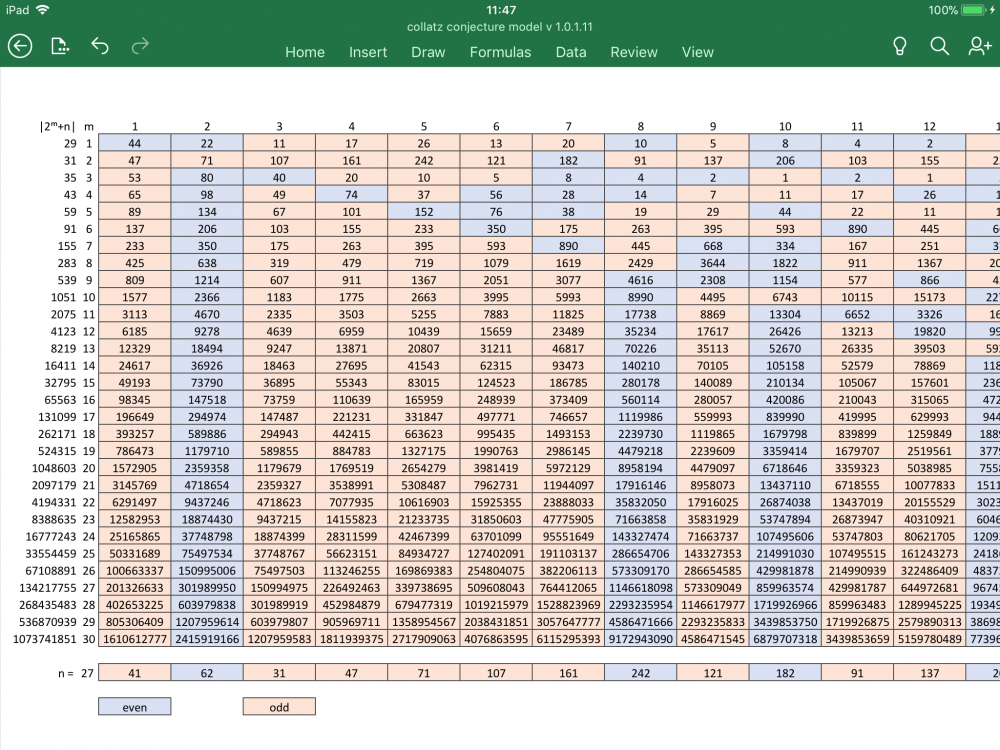-
Posts
511 -
Joined
-
Last visited
Content Type
Profiles
Forums
Events
Everything posted by TakenItSeriously
-

Dark Matter or Dark Force
TakenItSeriously replied to TakenItSeriously's topic in Astronomy and Cosmology
Yeah, but hard work I can handle, its just that without a short term memory I have to rely only on long term memory and LTM is apparently choosy about what it retains and just rejects stuff that has no meaning. For example, if I’m reading something and come accross a paragraph that makes no sense to me I literally have no memory of its contents. I know I read it but couldn’t tell you a single word of what I read. It made academics a nightmare because, unless I could get a question answered in realtime, the rest of the lechture was just white noise. 1 on 1 I could learn practically anything very quickly because I could ask why and have it answered, but probably not with particle physics because knowing why something happens apparrently stops working at the fundamental levels below Quantum Mechanics and thinking “it just does” doesn’t help me to retain it. -

Dark Matter or Dark Force
TakenItSeriously replied to TakenItSeriously's topic in Astronomy and Cosmology
Well, this is where the real downside of my 2e condition kicks in. If I cant understand something as I’m reading it, I can’t retain it and Particle Physics seems like arbitrary facts to my mind. I understand that its not, mind you, I just can’t understand why its not. -

Dark Matter or Dark Force
TakenItSeriously replied to TakenItSeriously's topic in Astronomy and Cosmology
I understand but thats kind of my point. If you remove all properties of matter but its mass , how is it different from saying matterless mass? -

Dark Matter or Dark Force
TakenItSeriously replied to TakenItSeriously's topic in Astronomy and Cosmology
But without EM forces, whats the difference? -

Dark Matter or Dark Force
TakenItSeriously replied to TakenItSeriously's topic in Astronomy and Cosmology
It sounds like your describing matterless mass which is difficult for me to comprehend. -

Dark Matter or Dark Force
TakenItSeriously replied to TakenItSeriously's topic in Astronomy and Cosmology
Here is the reference he gave for the relative motion of Brown Dwarfs.. Fuchs B., Jahreiss H., Wielen R., 1999, Kinematics of Nearby Subdwarfs, Ap&SS, 265, 175 Thanks for the detailed explanation. I understand your points on the local sparsity of DM or how it creates a spherical halo surrounding galacies, which I assume have all been modeled to fit the rotation curves of visible matter. But that puts cause before effect which I don’t have a problem with if it results in resonable conclusions, except I dont see how the dispersal of DM could seem reasonable since gravity acting upon visible matter doesn't behave that way. Its as if DM has one way properties of gravity that effects the motion of visible matter but is not itself effected by gravity or any of the laws of nature for that matter. Yet we know that the location of dark matter does seem to occupy roughly the same regions of space as visible matter in the very large scale based on the evidence of the lense effect so it must have some kind of tie to visible matter. Now, if you take a step back and look at the described model as if it were a model of loop fields instead of particles of matter wouldn’t it seem to make more sense to you? -

Dark Matter or Dark Force
TakenItSeriously replied to TakenItSeriously's topic in Astronomy and Cosmology
I’m unfamiliar with the methods scientists use to cite sources. He gave names and years in parentheses in the body of the paper and gave a list of references but I didnt see any way to link the two. Can you give me a hint as to what is required? Also how to access research data if its possible, (I really didnt think it was stored in the public domain) -

Dark Matter or Dark Force
TakenItSeriously replied to TakenItSeriously's topic in Astronomy and Cosmology
I found it in this site’s data hosted Bernard Bligh where he provided sources http://altcosmology.com/The-Sun-is-Electrically-Positively-Charged.php It was part of his evidence for his hypothesis that the sun has a slightly positive net charge which, given the size of stars, is a large absolute value. He argues that the consequences are that there is no need for extra mass of DM to explain the orbits of Stars in spiral galaxies, based on EM forces, but I wouldn’t want to misquote him so I dont want to go into the details of his paper. However, he also made a compelling arguement that the velocity profile of stars are not smooth but scattered and using DM to explain the motion would require a smooth curve. The only model that I can think of that could provide that kind of scattered motion would be something analogous to loop inductance which behaves globally but but can interact locally. The analogy would end up as a near-field/far-field crosstalk effect. Its a very difficult property to easily explain. -

Dark Matter or Dark Force
TakenItSeriously replied to TakenItSeriously's topic in Astronomy and Cosmology
If DM exists all around us, why do the planets in our solar system move in orbits that are predicted by visible matter alone? Also Brown Dwarfs orbit galaxies at speeds far below the flat oribital velocities that hot stars orbit at. -

Dark Matter or Dark Force
TakenItSeriously replied to TakenItSeriously's topic in Astronomy and Cosmology
That’s what I don’t understand. How can we know that it couldnt be a force that we don’t yet understand? Or if it were gravity from some kind of undiscovered particle that has the properties of a WIMP, why would the DM gravity only influence the motion of matter that was in a plasma state and not influence the orbits of planets or stars that were too cool to exist in a plasma state? -

Dark Matter or Dark Force
TakenItSeriously replied to TakenItSeriously's topic in Astronomy and Cosmology
I’m probably partly to blame. Speculation invites speculation I’ll try to be more careful. -

Dark Matter or Dark Force
TakenItSeriously replied to TakenItSeriously's topic in Astronomy and Cosmology
Edit to add. oops, I just read Vmedvl’s reply and I guess you were referring to his post? Never mind. -

Dark Matter or Dark Force
TakenItSeriously replied to TakenItSeriously's topic in Astronomy and Cosmology
Well, you should do what you feel is right. However, I would like to understand your reasoning. Are you saying that the extra orbital motion of stars around their galactic centers are not induced by some kind of unknown force? -

Dark Matter or Dark Force
TakenItSeriously replied to TakenItSeriously's topic in Astronomy and Cosmology
Noted. Sorry about that. Strange‘s arguement against the name change was that all hypothesis based on forces or fields alone have been shown to be logically inconsistent and only discovery of particles could explain the effects of DM. I only used that hypothesis as an example to refute his claim, ie. it hasnt been proven to be inconsistent as he suggested, its just not been rigorously validated yet which I still hope to do some day. However, while I will probably introduce as a new hypothesis in speculations one day, I have no time on my plate to try and defend it right now, so there is no need to move it to speculations at this time. Sorry again for any confusion I may have created. -

Dark Matter or Dark Force
TakenItSeriously replied to TakenItSeriously's topic in Astronomy and Cosmology
Not true. Look up how loop inductance fields in the far field induces motion in neighboring loops of charged particles. which would be the analog to DM While capacitance is the analog to gravity in the near field that radiates attractive forces according to F = K⋅c₁c₂/r² which can even divert the path of a light wave. -

Dark Matter or Dark Force
TakenItSeriously replied to TakenItSeriously's topic in Astronomy and Cosmology
I don't have to as their is a proper analog that already exists and can explain all those things which are the electromagnetic loop fields -

Dark Matter or Dark Force
TakenItSeriously replied to TakenItSeriously's topic in Astronomy and Cosmology
Actually If you modeled gravity and dark matter forces in a loop field that consisted of particles moving along world lines from Big Bang to Black Holes and negative energy returning over parallel dimensions in deterministic reverse time from white Holes to the Big Crunch. Then it should create a consistent model for gravity that radiates in the near field and dark matter that can induce motion of stars or plasma clouds in parallel world lines in the far field loops around their galactic cores or organize the movements of multiple galaxies over distinct intergalactic tendrils of space. -

Dark Matter or Dark Force
TakenItSeriously replied to TakenItSeriously's topic in Astronomy and Cosmology
I’ve never heard of teleparallel gravity but the name sounds like it could be related. Do you have a link to a good source? Never mind, I found it in Wikipedia. Very interesting, thanks! -

Dark Matter or Dark Force
TakenItSeriously replied to TakenItSeriously's topic in Astronomy and Cosmology
Maybe, but so could a far field gravity loop force such as the type that we know exists in Electromagnetic Fields theory. -

Dark Matter or Dark Force
TakenItSeriously replied to TakenItSeriously's topic in Astronomy and Cosmology
it’s not being pandentic to call a force a force and matter matter since they are not equivalents. Using “Dark Matter” is an unwarranted assumption that creates a bias in peoples minds and causes scientists to look far particles when they should be focusing on unknown forces that may or may not be caused by matter. -
Can we stop using the name “Dark Matter” for the name of the unknown force that induces the extra motion of stars around a galaxy or induces the paths of galaxies to follow paths of intergalactic tendrils and instead call it by all we know is true in that there must be a Dark Force that induces those properties in the Universe?
-

Proof for the Collatz Conjecture
TakenItSeriously replied to TakenItSeriously's topic in Mathematics
BTW, here’s the pattern with the data included in case you were wondering. The numbers just got too large to easily display.. -

Proof for the Collatz Conjecture
TakenItSeriously replied to TakenItSeriously's topic in Mathematics
Correction: In case anyone tries to verify the results shown in the pic, I mislabled the odd and even numbers. the light blue cells should be even numbers while the peach colored cells would be odd. -

The Cause of Prime Numbers ( Suggestion)
TakenItSeriously replied to Randolpin's topic in Mathematics
In response to the OP before reading through the entire thread, your premise has already been covered in the thread that discussed my discovery of a prime factor harmonic matrix, though your misunderstanding concept of what causes the locations of primes numbers to be where they are. The locations of primes are not directly distributed by the periodicity of their prime factors. They are indirectly determined by the positions of the composite numbers that the periodicity of prime factors create. Another words, Primality or the positions of prime numbers are only detemined by what’s left over after all composite number positions within a given range have already been determined. Which is exactly how number siev’s work. Note, that since a number sieve was the first image I used in that post, you can see it in the link I provided which is making me rethink the first image that I put in posts from now on, since it gives the impression that I’m describing a number seive and not a PFHM That’s one of the reasons, though not the main reason, why it takes so long to calculate their positions when they get large and also why they seem to have a random like property in their distribution. -

Proof for the Collatz Conjecture
TakenItSeriously replied to TakenItSeriously's topic in Mathematics
As I left this proof in the last post, I had believed that there was an even distribution of odd to even numbers within a Mersenne range that must eventually force a series to converge only my mistake was that I could only demonstrate that distribution existed in the y axis (positive integers) and not necessarily in the x axis (the series of integers created by the conjecture) as shown in Fig 1 in the second post. However I noted that mersenne numbers and perfect squares showed a direct correlation such that given a mersenne number (2ᵐ-1) or aperfect square (2ᵐ) the series would initially expand with m+1 odd numbers in a row for the mersenne numbers but would contract directly to 1, with m even numbers in a row e.g. for m = 5, then MN = 31 and the PS = 32 their series would respectively begin as: 31, 47, 71, 107, 161, 245... or 6 odd numbers 32, 16, 8, 4, 2, 1. or 5 even numbers plus 1 showing that there must be something that linked the x axes to the y axes in terms of their odd or even results with respect to their exponential integers. After following up on those clues: I believe that I made a profound discovery that may provide the missing step to finishing this proof which is based on showing that a hidden symmetry exists between the x & y axes. However, I’m still uncertain of if or how it prooves that the distribution of odd to even numbers must force a convergence at least as far as I can understand it, at the moment, at least until I have had time to digest this rather odd discovery a little more. Perhaps a mathematician can interpret it better. Since the pattern itself clearly shows that an x to y symmetry exists without yet fully understanding how it works right now I will first just show the pattern I discovered: Figure 2: the first 30 of 64 numbers in a series for n = 27 are shown.for a series produced by the collatz conjecture, bottom row. The 30 x 30 matrix above represents 30 numbers in the y axis that each produce their own series in the x axis (first 30 only are displayed). The function that produces the numbers for the y axis is: *f(y) = 2ᵐ+n for y = (1:30) where n is some positive integer m is position in the series and also the exponential in the function. * note: I’m sure I expressed that improperly, but I was in too much of a hurry to post to look up the proper symbology form which I can never seem to retain due to my disfunctional short term memory) Note that one important consequence of this function is that for any position (m) in a series for any given number (n), you can calculate which numbers will produce the identical pattern of odd and even results up to that parcicular position, after which, the series will always diverge, taking independent paths. eg. for n = 31 and the 6th position in the series: n = 31: 31, 47, 71, 107, 161, 242, 121, 182 y = 2⁶+31 = 95 n = 95: 95, 143, 215, 323, 485, 728, 364, 182... e.i. both series begin with 5 even numbers and 1 odd but they diverge ofter that. o,o,o,o,o,e,o,e o,o,o,o,o,e,e,e if we chose m = 7 then the pattern would be identical to 7 positions. I hope to follw up with a more detailed, and clearly stated explanation shortly. Edit to add: After reading through it again, the reason I found the math confusing is probably due to the fact that its not using known math that I’m familiar with. The function which typically describes a curve or relationship between x and y axes is actually describing a scale of the y axes. I’m not sure this operation or methodology falls into any particular field of math so it may require some new form math, though I’m certainly no expert in terms of math.




